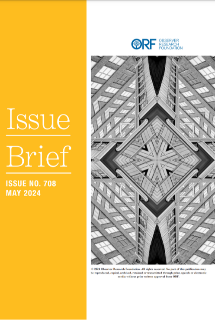
On 15 November 2021, Russia carried out a Direct-Ascent Anti-Satellite (DA-ASAT) test by shooting down one of its old satellites. The ASAT is a space weapon that is meant to target enemy satellites, which would cripple the enemy’s military ability to operate in the battlefield. These weapons could be used to target civilian satellites as well, the consequences of which in today’s modern world would be catastrophic. An unintended but foreseeable result of the test was the creation of a massive amount of space debris which even threatened the lives of astronauts on board the International Space Station. Numerous countries led by the Unites States condemned this test and described Russia’s actions as “simply irresponsible” and a threat to the “long term sustainability of . . . outer space”.
So far only China, Russia, India, and USA have successfully test fired ASAT weapons while many other nations are in the process of developing ASAT weapons of their own. Apart from these weapons, other forms of space weapons that have already been developed include lasers targeted towards enemy satellites, jammers, plasma attacks, and orbital ballistic missiles. Realistically speaking, we are only at the nascent stage of arms race in the space.
An unintended but foreseeable result of the test was the creation of a massive amount of space debris which even threatened the lives of astronauts on board the International Space Station.
Space: The global common
It is imperative to keep in mind that outer space is categorised by international law as a ‘Global Common', which traditionally means an area whose global economic resources lie beyond national jurisdiction of any state and are regulated by international law. Examples include the high seas, Antarctica, and even the cyberspace.
To regulate use and exploration of outer space, the UN General Assembly set up the Outer Space Committee in 1959, which then drafted the Outer Space Treaty (OST), the main purpose of which was to make outer space a global common for all mankind or as it says, ‘province of all mankind’. The OST lays down that “Outer space, including the Moon and other celestial bodies, is not subject to national appropriation by claim of sovereignty, by means of use or occupation, or by any other means” and “The establishment of military bases, installations, and fortifications, the testing of any type of weapons and the conduct of military manoeuvres on celestial bodies shall be forbidden.” Further, it provides that “States shall not place nuclear weapons or other weapons of mass destruction in orbit or on celestial bodies or station them in outer space in any other manner.” The most important factor related to global commons here is that the use of international space for ‘peaceful exploration’ is an established customary international law.
Global commons under threat
Lately, this long held international ideal is losing its importance, as observed by recent developments. Former US president Donald Trump even explicitly stated that “the United States does not view as a global common”. In furtherance of its stance, USA recently founded a space dedicated military command which is simply known as Space Force. Not to be outdone by the Americans, both China and Russia had established space dedicated military commands of their own, known as Strategic Support Force and Aerospace Defence Forces, respectively. Even those countries that do not have a dedicated space command are investing heavily in military applications in space. Iran is devising cyberattacks that could interfere with satellite systems and even North Korea is working on jamming radio frequency signals transmitted to and from satellites. Space is becoming more and more militarised by the day. In fact, it has already been dubbed as the next frontier for war.
Iran is devising cyberattacks that could interfere with satellite systems and even North Korea is working on jamming radio frequency signals transmitted to and from satellites.
The question here arises, how are countries increasingly militarising space without consequence in the presence of international treaties? The answer to the question is weak and ambiguous international law.
First and foremost, countries are divided on the phrase “peaceful purposes”. According to Russia, this phrase means ‘non-military’ purpose as used in the Antarctic Treaty 1959 in the context of demilitarisation. As per this interpretation, all military-related activities in space should be illegal. This is termed as the Non-Military theory. On the other hand, USA asserts that it means ‘non-aggressive’ and accordingly, all military purposes are lawful as long as they remain ‘non-aggressive’ as per the UN Charter, which prohibits ‘the threat or use of force’. This is called the Non-Aggressive theory. According to the late Professor Bin Cheng, who was a world authority on international air and space law, “To argue that it means 'non-aggressive' leads to illogical, unrealistic, and even absurd consequence”. Till date, there has been no protest from other states on this interpretation as US has not tried to implement its interpretation by carrying out “non-aggressive” or military activities on celestial bodies. However, this interpretation does leave room for the US and other states to further militarise space within the ambit of international law.
Secondly, the basic principles laid down by OST for the use of weapons in space is that “States shall not place nuclear weapons or other weapons of mass destruction in orbit or on celestial bodies or station them in outer space in any other manner.” The key here being the first principal concerning prohibition of weapons of mass destruction and nuclear weapons. This means that the countries retain the ability to weaponise space, and as long as countries do not use nuclear weapons, all other types of weapons can be justified due to the flexible interpretation of the treaty.
Another hurdle towards effective governance of space is enforcement. Currently, there is no organisation that is empowered to regulate space. The OST is enforced by the United Nations Office for Outer Space Affairs (UNOOSA), which lacks the legal and structural capacity to effectively regulate space. Without an effective enforcement agency, the fate of space will be left to the discretion of countries, who more often than not will try to further their national interests rather than cooperate.
How can space be saved?
The answer to the above question may seem simple enough, which would be to bring in a new concise and detailed treaty, which lays down specific provisions for arms control and demilitarisation. However, it is not quite so. This endeavour was taken up by China and Russia, who together submitted a draft treaty in 2008 to the Conference on Disarmament, which was called Prevention of the Placement of Weapons in Outer Space and of the Threat or Use of Force against Outer Space Objects (PPWT) in an effort to stop further militarisation of space. The PPWT defined what constitutes “Space weapons” and even the ‘intention to harm’ which would differentiate military and civilian technology as most of the civilian satellites can have military applications. This treaty could have very well answered the prayers for an effective governance of space militarisation. In 2014, a revised draft of the PPWT was submitted by the two countries but as was the case in 2008, USA rejected the draft on the pretext that since there is no arms race in space at the moment, there was no need for an arms control treaty. Since USA’s reliance on space technology has grown now more than ever, it is not going agree to a similar treaty anytime soon.
The PPWT defined what constitutes “Space weapons” and even the ‘intention to harm’ which would differentiate military and civilian technology as most of the civilian satellites can have military applications.
Any revised treaty in the future would only be a short-term solution as the issue is too complex to be solved by a mere treaty. What can be done for a long-term sustainable model for effective governance of space and restoring its position as a global common, is building a global governance system which can keep a check on space activities of all member states. This governance system could be founded on global understanding of the Earth orbit as a global common, which would have a centralised accountability mechanism that allows effective enforcement. This would help not just in demilitarising space, but also help the issues like growing space debris, decommissioning satellites, and even boost space exploration. This may appear to be a pipe dream, but history has shown us that countries can indeed come together to effectively manage other global commons. The Convention on Long-Range Transboundary Air Pollution and subsequent protocols are great examples of the same.
Conclusion
For the welfare on the entire mankind, it is imperative that the notion of space as a global common is restored. Stronger international agreements with a powerful enforcement body may only be the first steps in ensuring that mankind’s exploration of the great unknown is unhindered. A global governance system is only the next logical step towards the advancement of humans beyond this earth. How a nation conducts their actions in space affects all countries on the planet, good or bad. Therefore, a centrally controlled governance system which ensures a responsible and safe ecosystem for space exploration and unhindered access to a peaceful space for our future generations is the need of the hour.
The views expressed above belong to the author(s). ORF research and analyses now available on Telegram! Click here to access our curated content — blogs, longforms and interviews.




 PREV
PREV


